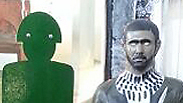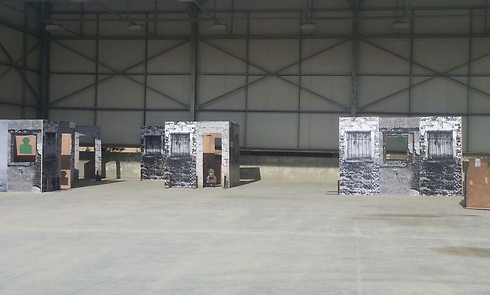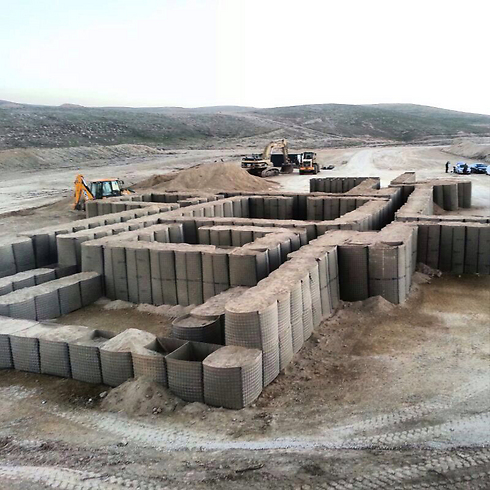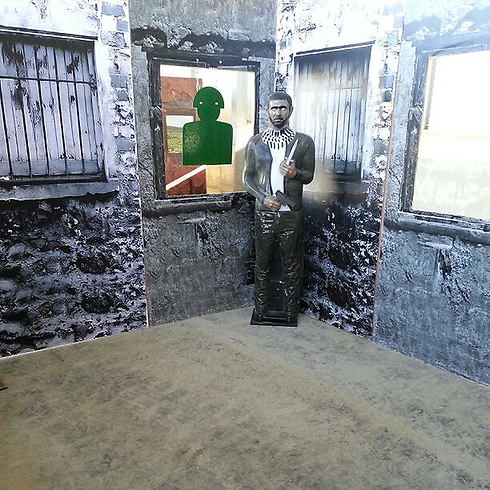
IDF revolution – seismic shift in training methods
Israel's military has overhauled its training apparatus, including the construction of a mock Lebanese village for use by ground troops.
A third Lebanese war or a ground operation in Syria are just a step away in terms of the IDF's new training patterns for ground troops, enlisted and reservists alike: A site with 300 hundred structures simulating a Hezbollah village, new state-of-the-art bullets, and instead of the old man-shaped cardboard cut outs as targets – "smart" targets (including ones that represent women and children).
In recent decades, there hasn't been an Israeli soldier who has not encountered the gun-toting soldier-shaped brown cardboard target. The only "upgrade" the cutout underwent in recent years is the addition of a red balloon, a rather primitive way of letting a fighter know if he hit the target.
Related stories:
- IAF welcomes Super Hercules aircraft
- IDF warns of budget cuts' debilitating effects
- Inside the IDF's elite naval commando unit
In the near future, the IDF will get rid of these outdated man-shaped targets and move to "smarter" ones, portraying innocent women and children to weaned out from the terrorists soldiers must hit.
This is only a small part of the well-planned transformation of ground soldiers' training. Among other things, new training will include a simulation of a massive "Lebanese village" in the Golan Heights, a new safer type of live bullet for "free" shooting and ground battles that simulate shooting from both sides using an improved laser system.
The plan seems designed for the northern front, and combines new techniques to take over Syrian army posts. It appears to be the preparation of the infantry, armor and engineering forces compatibility for large-scale ground maneuver in the event of a third Lebanese war.
The goal is to familiarize battalion soldiers, who will form the critical mass in a ground operation in Lebanon or Syria, with what they could expect to encounter in the field.
The Ground Forces Command has been planning part of the new training plan for more than a year. It has been building an innovative training facility to resemble a huge Lebanese village of 300 structures, including homes from which rockets are launched, mosques, Hezbollah's command and control headquarters, public buildings, difficult terrains (such as dense foliage and streams running through the center of the village), tiny villages on the edge of towns, mountainous extensions and fissured valleys supposed to challenge the forces as they try to take over the village.
The last time the IDF built such an extensive training facility was a decade ago, when a similar "village" – simulating a Gaza neighborhood – was constructed at the Tze'elim military training base in the south. The construction cost of the facility in the north is estimated to run into the tens of millions of shekels, and will be named the "Snir Facility", after the creak that runs close to the site.
The facility will be located in the area between the Galilee Panhandle and the northern Golan Heights. A little further north is the Nimrod Fortress, used in the Israeli movie "Beaufort" about a mythological IDF post in southern Lebanon.

An underground network of tunnels will be built under the new village, in which battalion soldiers will train just as if they were assaulting a hill or conquering a structure occupied by Hezbollah fighters.
This training is meant to prepare combat soldiers to face the threat of the underground tunnels that now exist in hundreds of Shi'ite villages in southern Lebanon. Anyone could get caught down there, not just troops from the Yahalom unit of the combat engineering corps, which specializes in fighting underground.
The facility is expected to go into operation in 2017; until then, military training facilities in urban terrain are being upgraded in order to reinforce the concept of a new-old threat from the north, not just the one from the land of Hezbollah.
IDF's new playground
"A whole brigade could drill taking over an entire village in the new facility – it will be a real live playground," says Col. Oren Abman, head of the Ground Forces Division in the IDF's GOC Army Headquarters, who is leading this ambitious program.
"It will include tank forces that will fight in urban territory and the operation of observation methods from the nearby Nimrod Fortress. One needs to keep in mind that we relocated about a third of the army's ground training from the south to training areas in the north," he says.
With all due respect to the classic threat from Hassan Nasrallah's Hezbollah organization, the civil war in Syria, which in the past year has enflamed the border with Israel on the Golan Heights, has reminded the army's upper echelons of the need to refresh plans for a ground operation, even a limited one, on the other side of the border.
In recent months, the Ground Forces began to spread huge, portable sand bags throughout the training facilities, representing combat in ditches, tunnels and alleys, some simulating the Syrian army posts. One advantage of the new system is roofless ditches, which affords senior commanders a closer look at the fighting and the fighters a more valuable experience during the drill.
"We are beginning to bring back the focus to these fighting techniques, above and underground," adds Abman. "We learned this method of using sand bags from the Americans, who built this type of post in Iraq. As part of the program, the current training period for each fighter (six months for infantry) will change. We double or even triple the amount of time spent on fighting in confined quarters, even at the expense of other aspects of basic or advanced training," he stresses.
Preventing another Goldstone
Replacing the cardboard cutouts wasn't due solely to technological developments. The new "smart" targets will be multi-purpose, life-sized armed terrorists, or, alternatively, an older woman or a child. They will be positioned inside a room that the fighter will attack under live fire. Hitting the child or woman instead of the terrorist will be considered a failed drill.
The IDF is trying to minimize the chances of another Goldstone Report – the conclusions of a UN fact-finding mission after the IDF's Operation Cast Lead in 2008 – given the international implications. Israel knows that in the next conflict, Hezbollah will aspire to transfer the fighting centers from the open spaces of southern Lebanon to the heart of the civilian population.
The dummy targets are just a part of the upgrade to an urban "field of fire" terrain used in training. The dummies can be dispersed throughout rooms made of cheap and portable plywood, thereby turning every shooting range into a mini-urban warfare within minutes.
Alongside these, 5.56 mm bullets are currently being tested as a real alternative to the paintball method of training. The new bullets contain a small amount of gunpowder, mark targets more efficiently, can be used alongside current IDF equipment and has a ballistic flight equal to that of a live bullet.
The bullets are also considered safer as they are unable to penetrate hard surfaces. This allows for freedom of firing with close to no safety restrictions during training in urban areas; they are already in use by the IDF elite units.
Another fundamental change now taking place, which has already been tested in the field, is the introduction of the MILES (Multiple Integrated Laser Engagement System), with which soldiers simulate shooting at each other using laser tagging.
This training method has existed in the army for several years, but often suffered technical failures and incorrect identification of "hits". Abman guarantees an improvement in reliability, explaining that with the new MILES, soldiers will also fire anti-tank missiles at IDF tanks during training, for example from an ambush."
Light at the end of the tunnel
Even as this pricey program, initially budgeted at 10 million shekels, was being developed, there were those in the IDF who were having a hard time accepting the drop reduction in the amount of training for troops in the last year and a half.
Chief of Staff Benny Gantz referred to this fall two months ago, calling it "getting closer to the 'red line'." Indeed, the data had begun to seem call back to the grim reality of the years before Second Lebanon War.
Some regular army battalions had gone for nine months without full training; some entire reservist units hadn't seen each other at all for two years or more.
"If a reservist brigade commander were to complain about not training in the past three years, his complaint would be justified," admits Abman.
"We were also forced to cut back on training for logistic units and one-day training sessions, and we also cancelled a small number of divisional drills. We went into this with open eyes, so that the situation would not continue into 2015," he says. "As such, this year we are already calling up brigades for 24 days in their sectors (one of these regiments suffered the destruction at the Yitzhar settlement outpost last week – YZ), with enhanced training."
Abman insists that this investment will pay off soon.
"We will see the light at the end of the tunnel next year, when the IDF returns to a full-scale training mode, in its new incarnation."












